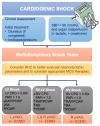Contemporary Evidence and Practice on Right Heart Catheterization in Patients with Acute or Chronic Heart Failure
- PMID: 38248013
- PMCID: PMC10814482
- DOI: 10.3390/diagnostics14020136
Contemporary Evidence and Practice on Right Heart Catheterization in Patients with Acute or Chronic Heart Failure
Abstract
Heart failure (HF) has a global prevalence of 1-2%, and the incidence around the world is growing. The prevalence increases with age, from around 1% for those aged <55 years to >10% for those aged 70 years or over. Based on studies in hospitalized patients, about 50% of patients have heart failure with reduced ejection fraction (HFrEF), and 50% have heart failure with preserved ejection fraction (HFpEF). HF is associated with high morbidity and mortality, and HF-related hospitalizations are common, costly, and impact both quality of life and prognosis. More than 5-10% of patients deteriorate into advanced HF (AdHF) with worse outcomes, up to cardiogenic shock (CS) condition. Right heart catheterization (RHC) is essential to assess hemodynamics in the diagnosis and care of patients with HF. The aim of this article is to review the evidence on RHC in various clinical scenarios of patients with HF.
Keywords: HFpEF; HFrEF; acute heart failure; advanced heart failure; cardiogenic shock; chronic heart failure; heart failure; right heart catheterization.
Conflict of interest statement
The authors declare no conflicts of interest.
Figures





Similar articles
-
[Contemporary epidemiology and treatment of hospitalized heart failure patients in real clinical practice in China].Zhonghua Xin Xue Guan Bing Za Zhi. 2019 Nov 24;47(11):865-874. doi: 10.3760/cma.j.issn.0253-3758.2019.11.004. Zhonghua Xin Xue Guan Bing Za Zhi. 2019. PMID: 31744275 Chinese.
-
Acute heart failure with mid-range left ventricular ejection fraction: clinical profile, in-hospital management, and short-term outcome.Clin Res Cardiol. 2017 May;106(5):359-368. doi: 10.1007/s00392-016-1063-0. Epub 2016 Dec 20. Clin Res Cardiol. 2017. PMID: 27999929
-
Five-year mortality of heart failure with preserved, mildly reduced, and reduced ejection fraction in a 4880 Chinese cohort.ESC Heart Fail. 2022 Aug;9(4):2336-2347. doi: 10.1002/ehf2.13921. Epub 2022 Apr 18. ESC Heart Fail. 2022. PMID: 35437939 Free PMC article.
-
Association of Non-Alcoholic Fatty Liver Disease With in-Hospital Outcomes in Primary Heart Failure Hospitalizations With Reduced or Preserved Ejection Fraction.Curr Probl Cardiol. 2023 Aug;48(8):101199. doi: 10.1016/j.cpcardiol.2022.101199. Epub 2022 Apr 9. Curr Probl Cardiol. 2023. PMID: 35405161 Review.
-
Characteristics and long-term prognosis of patients with reduced, mid-range, and preserved ejection fraction: A systemic review and meta-analysis.Clin Cardiol. 2022 Jan;45(1):5-17. doi: 10.1002/clc.23754. Epub 2022 Jan 18. Clin Cardiol. 2022. PMID: 35043472 Free PMC article.
Cited by
-
Utility of Simultaneous Left Atrial Strain-Volume Relationship During Passive Leg Lift to Identify Elevated Left Ventricular Filling Pressure-A Proof-of-Concept Study.J Clin Med. 2024 Dec 14;13(24):7629. doi: 10.3390/jcm13247629. J Clin Med. 2024. PMID: 39768551 Free PMC article.
-
Capillary refill time and tissue oxygen saturation as factors influencing lower limb ischemia in VA-ECMO: a case-control study.BMC Cardiovasc Disord. 2025 Mar 15;25(1):186. doi: 10.1186/s12872-025-04622-x. BMC Cardiovasc Disord. 2025. PMID: 40089689 Free PMC article.
-
Effects of Left Ventricular Unloading on Cardiac Function, Heart Failure Markers, and Autophagy in Rat Hearts with Acute Myocardial Infarction.Int J Mol Sci. 2025 May 6;26(9):4422. doi: 10.3390/ijms26094422. Int J Mol Sci. 2025. PMID: 40362660 Free PMC article.
-
Acute Heart Failure and Non-Ischemic Cardiomyopathies: A Comprehensive Review and Critical Appraisal.Diagnostics (Basel). 2025 Feb 23;15(5):540. doi: 10.3390/diagnostics15050540. Diagnostics (Basel). 2025. PMID: 40075788 Free PMC article. Review.
-
A predictive model for heart failure with preserved ejection fraction following acute myocardial infarction: the HFpEF-AMI score.BMC Cardiovasc Disord. 2025 Jul 23;25(1):535. doi: 10.1186/s12872-025-04969-1. BMC Cardiovasc Disord. 2025. PMID: 40702419 Free PMC article.
References
-
- Binanay C., Califf R.M., Hasselblad V., O’Connor C.M., Shah M.R., Sopko G., Stevenson L.W., Francis G.S., Leier C.V., Miller L.W., et al. Evaluation Study of Congestive Heart Failure and Pulmonary Artery Catheterization Effectiveness: The ESCAPE Trial. JAMA. 2005;294:1625–1633. doi: 10.1001/jama.294.13.1625. - DOI - PubMed
-
- Kittleson M.M., Panjrath G.S., Amancherla K., Davis L.L., Deswal A., Dixon D.L., Januzzi J.L., Yancy C.W. 2023 ACC Expert Consensus Decision Pathway on Management of Heart Failure with Preserved Ejection Fraction: A Report of the American College of Cardiology Solution Set Oversight Committee. J. Am. Coll. Cardiol. 2023;81:1835–1878. doi: 10.1016/j.jacc.2023.03.393. - DOI - PubMed
-
- Pieske B., Tschöpe C., de Boer R.A., Fraser A.G., Anker S.D., Donal E., Edelmann F., Fu M., Guazzi M., Lam C.S.P., et al. How to Diagnose Heart Failure with Preserved Ejection Fraction: The HFA-PEFF Diagnostic Algorithm: A Consensus Recommendation from the Heart Failure Association (HFA) of the European Society of Cardiology (ESC) Eur. Heart J. 2019;40:3297–3317. doi: 10.1093/eurheartj/ehz641. - DOI - PubMed
Publication types
LinkOut - more resources
Full Text Sources
Research Materials
Miscellaneous

